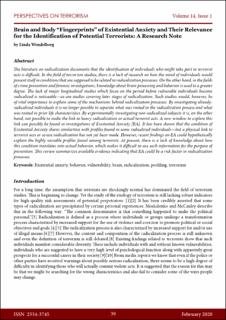| dc.contributor.author | Wendelberg, Linda | |
| dc.date.accessioned | 2020-05-25T11:10:03Z | |
| dc.date.available | 2020-05-25T11:10:03Z | |
| dc.date.created | 2020-02-21T14:13:55Z | |
| dc.date.issued | 2020 | |
| dc.identifier.citation | Perspectives on Terrorism. 2020, 14 (1), . | en_US |
| dc.identifier.issn | 2334-3745 | |
| dc.identifier.uri | https://hdl.handle.net/11250/2655446 | |
| dc.description.abstract | The literature on radicalization documents that the identification of individuals who might take part in terrorist acts is difficult. In the field of terrorism studies, there is a lack of research on how the mind of individuals would present itself in conditions that are supposed to be related to radicalization processes. On the other hand, in the fields of crime prevention and forensic investigations, knowledge about brain processing and behavior is used to a greater degree. The lack of major longitudinal studies which focus on the period before vulnerable individuals become radicalized is noticeable—as are studies covering later stages of radicalization. Such studies would, however, be of vital importance to explain some of the mechanisms behind radicalization processes. By investigating alreadyradicalized individuals it is no longer possible to separate what was rooted in the radicalization process and what was rooted in prior life characteristics. By experimentally investigating non-radicalized subjects it is, on the other hand, not possible to make the link to heavy radicalization or actual terrorist acts. A new window to explore this link can possibly be found in investigations of Existential Anxiety [EA]. It has been shown that the condition of Existential Anxiety shares similarities with profiles found in some radicalized individuals—but a physical link to terrorist acts or severe radicalization has not yet been made. However, recent findings on EA could hypothetically explain the highly variable profiles found among terrorists. At present, there is a lack of knowledge about how this condition translates into actual behavior, which makes it difficult to use such information for the purpose of prevention. This review summarizes available evidence indicating that EA could be a risk factor in radicalization processes. | en_US |
| dc.language.iso | eng | en_US |
| dc.publisher | University of Massachusetts Lowell | en_US |
| dc.relation.uri | https://www.universiteitleiden.nl/perspectives-on-terrorism | |
| dc.rights | Attribution-NonCommercial-NoDerivatives 4.0 Internasjonal | * |
| dc.rights.uri | http://creativecommons.org/licenses/by-nc-nd/4.0/deed.no | * |
| dc.title | Brain and Body “Fingerprints” of Existential Anxiety and Their Relevance for the Identification of Potential Terrorists: A Research Note | en_US |
| dc.type | Peer reviewed | en_US |
| dc.type | Journal article | en_US |
| dc.description.version | publishedVersion | en_US |
| dc.source.pagenumber | 15 | en_US |
| dc.source.volume | 14 | en_US |
| dc.source.journal | Perspectives on Terrorism | en_US |
| dc.source.issue | 1 | en_US |
| dc.identifier.cristin | 1796562 | |
| dc.description.localcode | This work is licensed under a Creative Commons Attribution 3.0 License. | en_US |
| cristin.unitcode | 194,63,30,0 | |
| cristin.unitname | Institutt for informasjonssikkerhet og kommunikasjonsteknologi | |
| cristin.ispublished | false | |
| cristin.fulltext | postprint | |
| cristin.fulltext | original | |
| cristin.qualitycode | 1 | |

